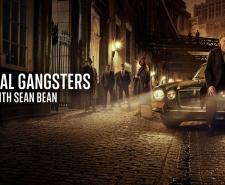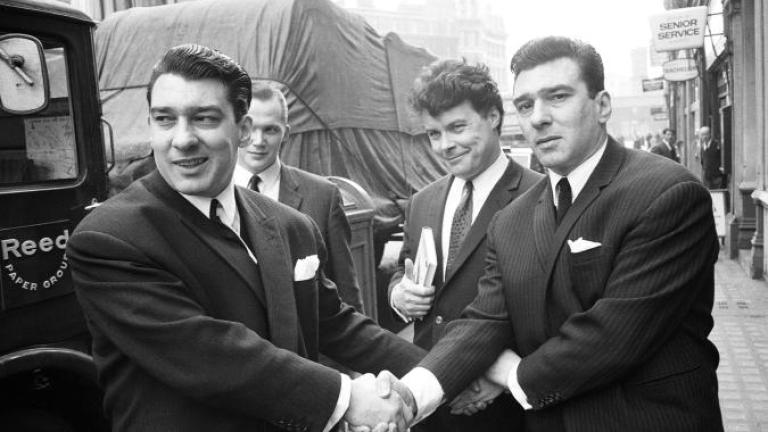
Original Gangsters With Sean Bean
Available now on Sky HISTORY or stream now on HISTORY Play

The following guest article was authored by Richard Bevan, a screenwriter who has written for television, radio and stage. As a specialist in true crime, Richard explores an often unknown side to two of Britain's most notorious gangsters, Ronnie and Reggie Kray.
Original Gangsters With Sean Bean, starting Tuesday 4 November on Sky HISTORY and HISTORY Play, will uncover the never-before-seen details of the exploits of history’s greatest gangsters, outlaws and troublemakers, including the Kray Twins. Coming soon to Sky HISTORY.
For a brief period in the late 1950s until their arrest in 1968, Reggie and Ronnie Kray ran an empire from the East End of London built on protection, gambling, and robbery. The tools used to establish, and control this enterprise was intimidation, assault, arson, and murder. And yet, they partied with London Society, hobnobbed with the aristocracy, and were feted by locals as charming rogues who 'made good' and gave back to the community.
What was it about 1960s London that allowed two ruthless and brutal thugs to rise from the morass of post-war England criminality to apparently become paragons of charity, kindness and compassion?
There was likely no better place for the transformation of the 'violent criminal' into the 'Good Samaritan' than the East End of London. For over 200 years the Dockers of London had created a code of honour that put family and fealty to your area and neighbours above the law. You married, and lived in a row house on a street with your Mum in another house, your aunt and uncle in another, your brother and his family in another etc. You got work through the people to whom you were related, owed a favour, or whom you knocked about with at school. If someone 'found' some extra cash, or some goods fell off a crane into a cousin’s loft space, it wasn’t anybody’s business. This was an impenetrable web of allegiances. You shared if you could, and you didn’t speak (grass) to the police - under any circumstances.
This insular society had distrusted authority and the establishment for generations. Everyone knew their place and role in life. But now, in 1960s London’s new meritocracy, distrust of authority, questioning norms, and confronting the class structure wasn’t just for the Dockers anymore.
The Krays made use of these changing social conventions, and new consumerist attitudes to create what today would be called a 'brand'. Then they studiously controlled and burnished that brand to great effect over many years.
They extended the community control they exercised in their East End 'Manor' across London using the same tools of intimidation, and blackmail, but coupled them with new tools like influence peddling, photography, fashion, art, and celebrity journalism.
Rather than dip into the glamorous nightclubs, Judy Garland, Frank Sinatra and the Princess Margaret set, let’s take a quick look at exactly what the Krays got up to when not posing for David Bailey, or attending film premieres:
They were responsible for at least two murders of their own dodgy confederates, numerous violent armed robberies, arson, dozens of serious assaults by their own hand or at their command, and protections rackets across East London and the West End of the city. That’s thousands of direct and indirect victims over about a decade.
Why weren’t they chased back to their manor like so many other upstarts throughout the years? And just how did two thugs get into a position where building a reputation for compassion, and charity was even an asset?
It was all a matter of it being exactly the right time and the right place. London may have been experiencing the Swinging 60s, but it was struggling. Its population during the decade actually shrank by 700,000 residents. 1960s London was in the process of reinventing itself yet again, and in the midst of huge change.
The usual stalwarts of the popular press - the people who the masses were supposed to venerate - had their own problems. The landed gentry were occupied with death duties, the Debutante Ball and attendant 'season' had been discontinued in 1958, and the usual society aristocrats were being described as 'genteel and distressed'. A vacuum opened up into which the 'self-made man', 'Tycoon', 'celebrity', and 'new rich' stepped.
The newspapers found themselves covering skinny working-class models decorating mews flats, instead of the Coming Out Ball of the daughter of Colonel Crichton-Stuart. 'Earl’s daughter' graced the breakfast tables of the city, instead of the 'daughter of an Earl'
. Businessmen, sports stars and entertainment personalities were puffed up to fill the pages in the highly lucrative, and highly competitive newspapers. The London popular press needed characters and stories. They needed the Krays.
What was 'blackmail' in Bethnal Green, was 'influence' in a West End gentleman’s club. What was a 'bribe' in Limehouse, was a 'charitable donation' in Piccadilly. What was 'money laundering' at Walthamstow dog track was 'investments' in commercial property development.
As part of their control of their manor in the East End, they had already learned to spread a bit of cash to buy loyalty, or at the least create a sense of indebtedness. They would also fund community events and make a show of helping 'struggling families' or businesses. The families of fathers whose leg they had broken, or businesses who were paying them protection were often 'grateful' recipients of their largess.
They had also made a point of 'being nice to women'. This meant they didn’t hit them or prostitute them. This was a stroke of genius as the East End was matriarchal in the home. And women talking create the legend on the streets.
It should be pointed out that this code didn’t extend to not taking a piece of the action from pimps who did work their patch.
In transferring these shady East End skills to the wider city, the twin’s greatest triumph was recognising that this new up-market would require greater subtlety and a gentler touch. Their new role was using the press and photographers to present themselves as 'striving and stylish entrepreneurs' who looked to their new friends to introduce them to the ways of this new world. And they knew how to make friends.
The first step out of the East End was extorting the sale of the West End nightclub Esmeralda’s Barn from the slumlord Peter Rachman. He was someone who understood violence and intimidation. It must have been a novel realisation for him to be the lesser monster in the room. The deal was done.
In 1960, a West End nightclub acted as an intersection at which worlds that wouldn’t normally meet came face-to-face. Aristos and criminals. The Honourables and the shameless. Celebrities and their adoring punters. Esmeralda’s Barn was a good night out for politicians, socialites, the rich, and the not so rich as long as they were respectful. And the Krays were generous hosts.
The next step to the celebrity munificence myth is getting control of what people say about you. And that takes power. Power earned by pandering to the tastes of the powerful men who frequent nightclubs. And to no one’s surprise those appetites are no different to those the brothers had been satisfying for years in the East End.
Instead of laundering money at Chelmsford track, they now laundered it with a friendly banker. Instead of making a girl available for a bit of information from a warehouse delivery clerk, they set up a rentboy party for Lords and MPs. Instead of getting a friend a gold watch for his actress girlfriend, they had a quiet word in the ear of the Features Editor of a national newspaper about a 'discovery he really wants to make'.
The Good Samaritan image wasn’t so much from their good works as it was from absolutely no one wanting to say a bad word about them. The loyalty and reputation they wielded in the East End through fear and violence, they wielded in the West End by contacts and influence. Those kindnesses extended were minor business expenses at worst, and investments in lucrative future endeavours at best. The Good Samaritan was a myth.
In the end, their impressive political contacts, generous donations, and glamorous socialite friends were good for an eight year run thrilling polite society with their gangster chic style. They were finally arrested in 1968 in the flat of a brutalist tower block into which their mother had been moved in the slum clearances - clearances that destroyed the allegiances of two centuries on the docks. But the myth of their good works continued, partly burnished by their own efforts at brand control through interviews and books from prison over many years. And it worked.
In 2001, I lived in the Krays mother’s tower Braithwaite House in EC1. Brutalism was back in style and the tower’s tenants were an uneasy mix of architectural student types and old time East Enders. Over 30 years after the Kray brothers arrest, an elderly neighbour and I were chatting in the lift one day and she lamented how the streets weren’t as safe today as they had been back when the Krays were in charge. Then she reached into her wire shopping trolley, pulled out a pair of knock-off Evisu Jeans and said, 'Here…whatcha give me for these?'